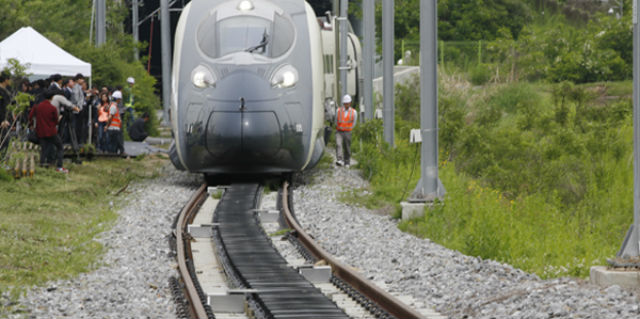To get up to top speed, bullet trains have to pull a huge amount of electrical current from the grid. typically through unsightly overhead power lines. But this newly debuted train prototype from South Korea sucks up electricity invisibly from the tracks below.
Developed through a collaboration of the Korea Advanced Institute of Science and Technology and The Korea Railroad Research Institute, this bullet train is the first rail vehicle utilise wireless power transmission. According to the Korea JoonAng Daily, the system works as such:
A power inverter located near the railway sends electricity of about one megawatt through power-transfer coils installed in the middle of track. The electricity forms a high frequency magnetic field of about 60 kilohertz, by switching the polarization from plus to minus 60,000 times per second. As the magnetic field spreads, a line of current collector coils in the train above the power-transfer coil in the track absorbs the magnetic field and immediately transfers it into about 1.2 megawatts of electricity.
That 1.2 MW is absorbed by one of four 300KW collector coils situated on the underside of each train car. It’s essentially the same type of wireless technology that has driven electric buses in the region for the past few years and has been proposed stateside for propelling electric passenger cars without the need for charging stations.
“The institute aims to start commercialising the wireless power technology on light rails in next five years,” Lee Jun-ho, a senior researcher at the institute, told JoongAng. “We will keep researching to advance the technology to make it applicable to subways and bullet trains like KTX.”
And though it only topped out at a pokey 4km/h (that’s slower than most folks walk) along a 150m long track in Uiwang, Gyeonggi last Tuesday, the prototype train could one day hit speeds of 400km/h. Researchers also estimate that such a system could reduce maintenance costs by more than half by eliminating the tangled web of existing overhead power lines. Looks like cord cutting is no longer limited to the realm of American cable television. [The Korea Railroad Research Institute via JoongAng Daily]
